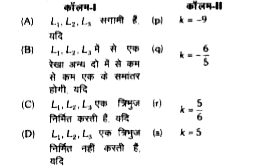ध्रुवीय रूप में सम्मिश्र संख्या z=i−1cos(π/3)+isin(π/3) है| (1)r=√2(cos5π12+isin5π12) (2) r=√2(cosπ4+isinπ4) (3)r=√2(cosπ6+isinπ6) (4) इनमें से कोई नहीं
r=√2(cos5π12+isin5π12)
r=√2(cosπ4+isinπ4)
r=√2(cosπ6+isinπ6)
इनमें से कोई नहीं
The correct Answer is:A
Step by step video, text & image solution for ध्रुवीय रूप में सम्मिश्र संख्या z=(i-1)/(cos(pi//3)+isin(pi//3)) है| (1)r=sqrt2("cos"(5pi)/12+"isin" (5pi)/12) (2) r=sqrt2("cos"pi/4+"isin" pi/4) (3)r=sqrt2("cos"pi/6 + "isin" pi/6) (4) इनमें से कोई नहीं by Maths experts to help you in doubts & scoring excellent marks in Class 12 exams.
Updated on:21/07/2023Topper's Solved these Questions
- सम्मिश्र संख्यायेंBOOK - ERRORLESS HINDICHAPTER - सम्मिश्र संख्यायेंEXERCISE - Jee Advanced (More than one correct Answers)
23 Videos
- सम्मिश्र संख्यायेंBOOK - ERRORLESS HINDICHAPTER - सम्मिश्र संख्यायेंEXERCISE - Jee Advanced (Reasoning)
6 Videos
- सम्मिश्र संख्यायेंBOOK - ERRORLESS HINDICHAPTER - सम्मिश्र संख्यायेंEXERCISE - Solved Multiple Choice Questions (डी मोयवर प्रमेय तथा इकाई के मूल )
59 Videos
- समुच्चय सिद्धान्त तथा सम्बन्ध BOOK - ERRORLESS HINDICHAPTER - समुच्चय सिद्धान्त तथा सम्बन्ध EXERCISE - JEE Advanced (Reasoning type questions)
3 Videos
- सरल रेखा BOOK - ERRORLESS HINDICHAPTER - सरल रेखा EXERCISE - JEE ADVANCE (Matrix Match type questions)
4 Videos
Similar Questions
माना z1 तथा z2 दो सम्मिश्र संख्याएँ इस प्रकार है कि z1≠z2 तथा |z1|=|z2| . यदि z1 धनात्मक वास्तविक भाग तथा z2 ऋणात्मक काल्पनिक भाग है, तब z1+z2z1−z2 होगा
View Solutionकथन-1: यदि n एक विषम पूर्णांक 3 से बडा है लेकिन 3 का गुणज नहीं है, तब (x+1)n−xn−1,x3+x2+x से विभाज्य है।
कथन-2: यदि n एक विषम पूर्णांक 3 से बड़ा है लेकिन 3 का गुणज नहीं है हम लेते हैं 1+ωn+ω2n=3
View Solution(cosθ+isinθ)4(sinθ+icosθ)5=
View Solutionमाना R वास्तविक संख्याओं का समुच्चय है
कथन-1 : A={(x,y)∈R×R:y−x एक पूर्णांक है} R पर एक तुल्यता संबंध है |
कथन-2 : B={(x,y)∈R×R:x=αy किसी परिमेय संख्या α के लिए} R पर एक तुल्यता संबंध है |
View Solution
View Solutionstatement-1(cosθ+isinθ)3=cos3θ+isinθ,i=√−1 statement-2(cosπ4+isinπ4)2=i
View SolutionIf z=cosπ4+isin(π6) ,then
View Solution(1+cosπ8−isinπ81+cosπ8+isinπ8)8
View Solution(cosπ6+isinπ6)1/2+(cosπ6−isinπ6)11/2
View SolutionThe product of the values of [cosπ3+isinπ3]3/4 is
View Solution⎡⎢ ⎢⎣1+cos(π12)+isin(π12)1+cos(π12)−isin(π12)⎤⎥ ⎥⎦72 =
View Solution(1+cos.π8+isin.π81+cos.π8−isin.π8)8=
View SolutionThe value of (cosπ2+isinπ2)(cos(π22)+isin(π22))(cos(π23)+isin(π23))
……….∞ is
View SolutionIf z1=√2(cosπ4+isinπ4) and z2=√3(cosπ3+isinπ3), then |z1z2| is
View Solution[(1+cos(pi//8)+isin(pi//8))/(1+cos(pi//8)-isin(pi//8))]^8 The value of
View Solutionयदि z=cosπ6+isinπ6 , तब (1)|z|=1,arg z=π4 (2)|z|=1 , arg z=π6 (3)|z|=√32,arg z=5π24 (4)|z|=√32,arg z=tan−11√2
View Solution
